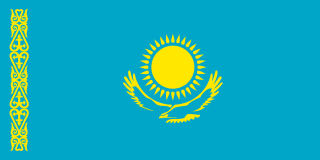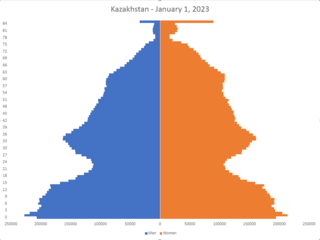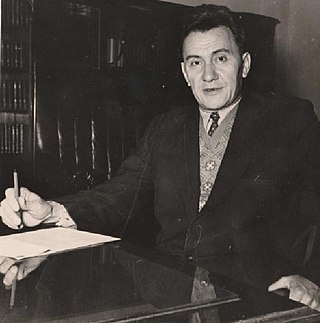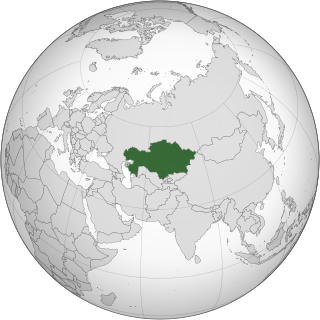Related Research Articles

Kazakhstan, officially the Republic of Kazakhstan, is a landlocked country mostly in Central Asia, with a small part in Eastern Europe. It borders Russia to the north and west, China to the east, Kyrgyzstan to the southeast, Uzbekistan to the south, and Turkmenistan to the southwest, with a coastline along the Caspian Sea. Its capital is Astana. Kazakhstan is the world's ninth-largest country by land area and the largest landlocked country in the world. It has a population of 20 million people and one of the lowest population densities in the world, at fewer than 6 people per square kilometre. Ethnic Kazakhs constitute a majority of the population, while ethnic Russians form a significant minority. Officially secular, Kazakhstan is a Muslim-majority country, although ethnic Russians in the country form a sizeable Christian community.

Kazakhstan, the largest country fully within the Eurasian Steppe, has been a historical crossroads and home to numerous different peoples, states and empires throughout history. Throughout history, peoples on the territory of modern Kazakhstan had nomadic lifestyle, which developed and influenced Kazakh culture.

The demographics of Kazakhstan enumerate the demographic features of the population of Kazakhstan, including population growth, population density, ethnicity, education level, health, economic status, religious affiliations, and other aspects of the population. Some use the word Kazakh to refer to the Kazakh ethnic group and language and Kazakhstani to refer to Kazakhstan and its citizens regardless of ethnicity, but it is common to use Kazakh in both senses. It is expected that by 2050, the population will range from 23.5 to 27.7 million people.

The Kazakh Soviet Socialist Republic, also known as Soviet Kazakhstan, the Kazakh SSR, or simply Kazakhstan, was one of the transcontinental constituent republics of the Soviet Union (USSR) from 1936 to 1991. Located in northern Central Asia, it was created on 5 December 1936 from the Kazakh ASSR, an autonomous republic of the Russian SFSR.

Dinmukhamed Akhmetuly "Dimash" Kunaev was a Kazakh Soviet communist politician who served as the First Secretary of the Communist Party of the Kazakh SSR.

The Polish diaspora comprises Poles and people of Polish heritage or origin who live outside Poland. The Polish diaspora is also known in modern Polish as Polonia, the name for Poland in Latin and many Romance languages.
The Jeltoqsan, also spelled Zheltoksan, or December of 1986 were protests that took place in Alma-Ata, Kazakh SSR, in response to CPSU General Secretary Mikhail Gorbachev's dismissal of Dinmukhamed Kunaev, the First Secretary of the Communist Party of Kazakhstan and an ethnic Kazakh, and his replacement with Gennady Kolbin, an ethnic Russian from the Russian SFSR
Ethiopian Americans are Americans of Ethiopian descent, as well as individuals of American and Ethiopian ancestry. The largest Ethiopian American community is in the Washington, D.C. metropolitan area, with some estimates claiming a population of over 200,000 in the area; other large Ethiopian communities are found in Minneapolis–Saint Paul, Las Vegas, Seattle–Tacoma–Bellevue, Denver, the San Francisco Bay Area, Los Angeles, Salt Lake City, Columbus, and South Dakota.

The history of the Jews in Kazakhstan connects back to the history of Bukharan and Juhuro Mountain Jews. Kazakh Jews have a long history. There are approximately several thousand Jews in Kazakhstan right at present.
Ghanaian Americans are an ethnic group of Americans of full or partial Ghanaian ancestry or Ghanaian immigrants who became naturalized citizen of the United States.
The number of Chinese people in Kazakhstan varies through the centuries. There have been various migrations of ethnic minorities from China to Kazakhstan in the 19th and early 20th centuries, such as that of the Dungan people (Hui) fleeing Qing Dynasty forces after a failed 1862–1877 rebellion in Northwest China or the Uyghur and Kazakh exodus from Xinjiang during the 1950s Great Leap Forward; however, their descendants do not consider themselves to be "Chinese people". The modern wave of migration from China only dates back to the early 1990s.
Shelek, formerly Chilik, is a town in Almaty Region of south-eastern Kazakhstan. Administrative center of Shelek rural district. It is located about 69 km north-east of the center of Esik. The KATO code is 194083100.

Turks in Kazakhstan are ethnic Turks who live in Kazakhstan, mostly from Meskheti after the Deportation of the Meskhetian Turks.
Poles in Kazakhstan form one portion of the Polish diaspora in the former Soviet Union. Slightly less than half of Kazakhstan's Poles live in the Karaganda region, with another 2,500 in Astana, 1,200 in Almaty, and the rest scattered throughout rural regions.
Uyghurs in Kazakhstan, or Uyghur Kazakhstanis, form the country's fifth-largest ethnic group, according to the 2009 census.
Armenians in Central Asian states: Uzbekistan, Kazakhstan, Kyrgyzstan, Tajikistan and Turkmenistan, were mainly settled there during the Soviet era for various reasons.
The following is a timeline of the history of the city of Almaty, Almaty Province, Kazakhstan.
Uzbek Americans are Americans of Uzbek descent. The community also includes those who have dual American and Uzbek citizenship.
Central Asians in the United States are Americans with ancestry from Central Asia. They include Kazakh, Kyrgyz, Tajik, Turkmen, and Uzbek individuals. People of Afghan, Baloch, and Uyghur descent are also sometimes classified as Central Asians. The United States census does not mention Central Asians under any category.
Kazakh diaspora is a term used to collectively to describe the ethnic or people of Kazakh descent who reside in outside of Kazakhstan across the world in various countries as a result of annexed territories and diasporic migration in the late 19th and early 20th centuries. It is estimated that more than four million Kazakhs live abroad. Although the Kazakh diaspora is usually a sparse one, particularly in Western Europe and United States, it retains ethnic enclaves within the countries of Turkey, Iran, and Afghanistan.
References
- 1 2 "Table 1. First, Second, and Total Responses to the Ancestry Question by Detailed Ancestry Code: 2000". U.S. Census Bureau. Retrieved 2013-06-28.
- ↑ "Place of birth for the foreign-born population in the United States, Universe: Foreign-born population excluding population born at sea, 2007-2011 American Community Survey 5-Year Estimates". United States Census Bureau. Retrieved 2022-05-11.
- ↑ Ph.D, Reed Ueda (September 21, 2017). America's Changing Neighborhoods: An Exploration of Diversity through Places [3 volumes]. ABC-CLIO. ISBN 9781440828652 – via Google Books.
- ↑ Mendikulova G. The Kazakh Diaspora: History and Modernity. - Almaty, 2006. - p. 264-268
- ↑ "U.S. Adopters of Foreign Orphans Undergo Tough Scrutiny | IIP Digital". Iipdigital.usembassy.gov. Retrieved 2014-02-06.
- 1 2 "Kazakh American Association". The Profile Engine. Archived from the original on 2018-08-12. Retrieved 2014-02-06.
- 1 2 Алексей Пименов (2010-04-19). "Казахская диаспора США: традиции и перспективы". Voanews.com. Retrieved 2014-02-06.
- ↑ https://www.migrationpolicy.org/programs/data-hub/charts/us-immigrant-population-state-and-county?width=1000&height=850&iframe=true.
{{cite web}}: Missing or empty|title=(help) - ↑ "Kazakh Aul of the United States - Events". Kazakh-aul-us.org. Archived from the original on 2014-01-01. Retrieved 2014-02-06.
- ↑ "Cultural Connections". Kazakh Adoptive Families. Retrieved 2014-02-06.
- ↑ Mendikulova G. The Kazakh Diaspora: History and Modernity. - Almaty, 2006. - p. 268
- ↑ "Indiana University: Department of Central Eurasian Studies. Related links".

